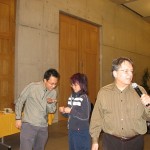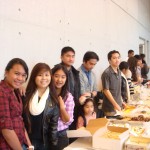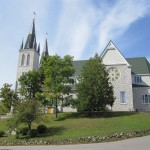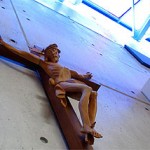Theology
By Roberto Chiotti, BES, B.ARCH, MTS, OAA, MRAIC, LEED AP
Principal
larkin architect limited
In 1998, the Passionist Community of Canada decided to provide a new legacy for St. Gabriel of the Sorrowful Virgin, a Roman Catholic parish in North York that it has served for over 53 years. This legacy constitutes the construction of a church that will include a 750-seat worship space, a generously proportioned narthex, offices, meeting rooms, and other support facilities for its ongoing ministries. More significantly, when it is completed in July 2006, it will become the first church in Canada to receive Silver certification from the Leadership in Energy and Environmental Design (LEED™) Green Building Rating System. LEED™ was developed by the U.S. Green Building Council and adapted for use in Canada by the Canada Green Building Council. Both organizations bring together industry leaders to promote high-performance sustainable buildings.
The new church replaces a 500 seat, deteriorating facility that had become prohibitively expensive to operate and maintain. “While reducing energy costs was one of the reasons for building a ‘green’ church, says Fr. Paul Cusack, C.P., current Pastor at St. Gabriel’s, “Our primary motivation was to establish a link between the sacredness of the gathered community of Faith and the sacredness of the Earth.” As such, the new church constitutes a dramatic departure in the design of sacred space. Unlike most churches built to inspire a sense of other-worldliness, the new St. Gabriel’s is designed to emphasize that when we gather to worship, we do so within the greater context of creation. It has been conceived as an articulation of the eco-theology of Passionist, Father Thomas Berry and his belief that we must work towards establishing a mutually-enhancing, human-earth relationship. This first of two articles attempts to identify the issues raised by eco-theology and how we can work towards healing our relationship with the Earth. The second article will explain how St. Gabriel’s new church demonstrates how we can respond to this imperative in a tangible, realistic, and meaningful way.
It has long been apparent that we are facing an ecological crisis of alarming magnitude. The daily news is filled with stories about the devastating effects of climate change; of deteriorating air and water quality; of the landslides caused by deforestation; of species that are endangered; of rising problems to human health. We are all inextricably part of a human process that is quickly bringing to an end the Cenozoic Age of geological history, that sixty-five million year period after the extinction of the dinosaurs when the great complexity and diversity of plant and animal life that we know today came to flourish. In our race to control and exploit the earth’s natural resources for the benefit of humankind, we have been blind to the fact that we are shutting down the very life supporting systems that we depend upon for our survival.
In response to this growing awareness, many theologians and scholars are realizing the need to re-visit scripture and the many insights on humankind’s relationship to creation that exist within our church’s rich tradition. On June 10, 2002 Pope John Paul II and Ecumenical Patriarch Bartholomew I of Constantinople signed a common declaration on environmental ethics in Rome and in Venice. In it they called for a new relationship towards the earth.
What is required is an act of repentance on our part and a renewed attitude to view ourselves, one another, and the world around us within the perspective of the divine design for creation.
This declaration suggests that creation is integral to God’s divine plan and that as humans, we need to be reconciled not just to each other, but to all of creation. Genesis 9:8-12 speaks of the sacred covenant that God established with humans, the animal world, and the earth.
God said to Noah and to his sons with him: See, I am now establishing my covenant with you and your descendents after you and with every living creature that was with you: all the birds, and the various tame and wild animals that were with you and came out of the ark. I will establish my covenant with you, that never again shall all bodily creatures be destroyed by the waters of a flood; there shall not be another flood to devastate the earth.
This scripture passage suggests that God has a covenantal relationship with not only humankind, but with all living creatures, and the earth. When, through our pervasive presence and destructive processes we cause the extinction or endangerment of other species and their habitat, then we are interfering with the covenant that God has with those creatures. Are we then not also called upon to view our own relationship towards other life forms as part of that same covenant? If so, then “dominion over” gives way to “responsible stewardship” encouraging us to let go of our exploitive ways, and to recognize the intrinsic value that other creatures and the rest of the earth share with humans in the eyes of God. In her book entitled Gaia and God, eco-feminist theologian Rosemary Radford Ruether concurs.
Although we have limited rights of use of other life forms, and also responsibilities of care and protection toward them, there is an ultimate thouness at the heart of every living being… We…encounter each other being simultaneously as ‘other’ and as kin. …Each has its own distinct relation to God as source of life, and not necessarily for our purposes…
For eco-theologians, both scripture and creation are revelatory. They have re-discovered that early Christians, the saints and the great reformers of the church have written eloquently about creation, emphasizing its ability to provide deep spiritual instruction about the nature of God. Frederick Krueger, in his book A Cloud of Witness: The Deep Ecological Legacy of Christianity, provides many references to support this view. The following are just a few:
Creation reveals Him who formed it, and the very work made suggests Him Who made and ordered it. St. Irenaeus of Lyon (129 -203)
I want creation to penetrate you with so much admiration that wherever you go the least plant may bring you a clear remembrance of the Creator….One blade of grass or one speck of dust is enough to occupy your entire mind in beholding the art with which it has been made. St. Basil the Great (347-407)
The whole earth is a living icon of the face of God. St. John Damascene (675-749)
God writes the Gospel, not in the Bible alone, but also on trees, and in the flowers and clouds and stars. Martin Luther (1483-1546)
Similarly Thomas Berry in his The Dream of the Earth quotes a passage from Thomas Aquinas’ Summa Theologica, to reflect this understanding.
Because the divine goodness ‘could not be adequately represented by one creature alone, He produced many diverse creatures, that what was wanting in one in the representation of the divine goodness might be supplied by another. For goodness, which in God is simple and uniform in creatures is manifold and divided; and hence the whole universe together participates the divine goodness more perfectly, and represents it better than any single creature whatever.’ From this we could argue that the community of all the components of the planet Earth is primary in the divine intention.
All of these writings suggest that with every diminishment of diversity, our understanding of God is subsequently diminished. The universe in all its wondrous modes of expression, both individually and collectively, is a celebration of its divine origin. Our art, our music, our rituals, and indeed our creativity are all informed by creation. It is not coincidental that these words share the same root. Imagine what our liturgies would be like if the diversity of life on the planet was not there to provide us with inspiration? Imagine for a moment how we would decorate our churches to reflect the liturgical seasons or how our scripture and prayers would have evolved if we lived all of our lives in a landscape that resembled the moon. Any threat to the earth’s ability to function in all its glory and provide the essentials of life must also be understood as a threat to religion. If the water is contaminated by pollution then it can’t be drunk or used in Baptism. Berry suggests that both in it’s physical reality and its religious symbolism, it becomes a source not of life, but death.
How do we weave ourselves back into the web of life? How do we become re-enchanted with the glory of creation? As an architect who designs sacred space, how can I respond to the insights revealed by eco-theology? Once again, I would like to return to the work of Thomas Berry for the answers. He believes that the real hope lies in our ability to re-establish an integrated sense of the whole, to redefine a cosmology based not upon an anthropocentric view of the human as primary but based instead upon a biocentric understanding of the earth as primary and the needs of the human as derivative. In order to do this, he believes we need first to examine the inner intentionality of God’s universe as manifested by its three creative principles: differentiation, subjectivity, and communion.
According to Thomas Berry, “differentiation” is the primordial expression of the universe. Out of the fiery violence of the “Big Bang” came radiation and differentiated particles that through a certain sequence of events, found expression in an overwhelming variety of manifestations. The universe is coded for an ever increasing, non-repeatable, biodiversity as exemplified by the incredible variety of life that has evolved on the earth. From its rich and abundant tropical forests to the stark beauty of its polar regions, the evidence of this tendency towards biodiversity is obvious. Humankind would not have appeared as a species if somehow the process towards increasing biodiversity had been allowed to shut down. In reality, we cannot help but be creative because the universe is creative. Our role as humans must now be to restore the earth’s ability to continue its growth towards complexity and differentiation.
The second primary creative principle of the universe as identified by Thomas Berry is that of increased “subjectivity”. Together, every reality that makes up a part of the universe is not just a collection of objects but is a community of subjects. As subjects, we all have an inner dimension, an interior reality which not only reflects the diversity that surrounds us but reflects the original bursting forth of energy at the beginning of time. Our creativity as humans is informed by the diversity of subjectivity that is allowed to declare itself around us. Any human activity that contributes to the impoverishment of the natural world will then inevitably contribute to the impoverishment of our sense of wonderment and awe. With every species that becomes extinct, every mountain that becomes scared by deforestation, every river that becomes polluted with our industrial wastes, the presence of the divine that inspires our creativity as humans, is diminished. Our own ability to survive as a species will depend to a great extent on the ability of all natural entities on the planet both living and non-living to develop their full potential apart from human influence as much as possible.
Thomas Berry’s third creative principle of the universe “is the communion of each reality of the universe with every other reality in the universe”. As mentioned before, we are an inextricably related community of subjects. This genetic interrelatedness of everything in the universe to everything else means that the universe is in dialogue with itself as a community. “Everything is intimately present to everything else.” The original bursting forth of energy at the beginning of time contained all the elements necessary for the evolution of the universe up to and including human culture. The potential for religion, liturgy, music, poetry, dance, art and architecture existed as part of that original expression. This is why we are connected to the stars in the night sky and to all living and non-living realities on the planet, why they are deserving of our awe and reverence, and why we must celebrate them in our creativity.
As humans, the time has come for us to forfeit our role as exploitive dominators and to assume the more responsible role of participatory co-creators with God by re-aligning our sense of creativity with the creative principles of the universe and the planet. Only then can we contribute to the healing of the Earth in all its life systems and achieve a relationship with the Earth that is mutually enhancing.
 Founded by St. Paul of the Cross, every Passionist takes a special vow to spend his or her energies in promoting remembrance of the sufferings of Jesus, the memory of the Cross, and reflection of the meaning of the Cross for the world.
Founded by St. Paul of the Cross, every Passionist takes a special vow to spend his or her energies in promoting remembrance of the sufferings of Jesus, the memory of the Cross, and reflection of the meaning of the Cross for the world.




